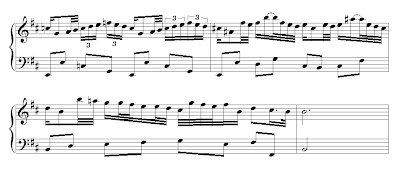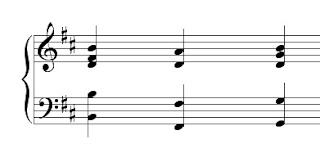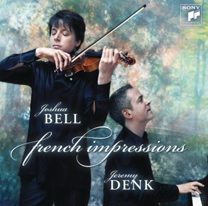An Allemande has two halves. There is something about this “two-halviness” that I think often gets forgotten, or taken for granted.
For me the following image is useful: suppose the first half of the dance is a drawing. Now for the second half, imagine Bach putting a piece of tracing paper over the first drawing … and retracing it, but not exactly, and then pausing and removing an arm from the original drawing and putting in another face, or part of a totally different drawing … In other words, he is passing over the ideas of the first half, but the translation is free, the words are affected, refracted, changed. The image of tracing paper is compelling to me, because it partly veils the original, the veil of the past.
Studious analysts, we can go through and chart all the alterations, note the composer’s developmental handiwork (here’s x, and here’s y, and they are reordered, etc. etc.) …
1st half A B C D E F G H I
2nd half A B C E J !!! a bit of F D K G H I (L) I
Whoa … that is one screwed-up anagram … but after you catalog all the changes, and reorderings, you are left with just this disheartening data and you may find yourself wondering what is it all for?
It is the already-heard-ness of it that is amazing… and perhaps often ignored …
In the second half, we are not visiting, but revisiting; we are haunted by a continuous deja-vu; everything same, but different; it is as if our steps (our “dance steps”) are compelled by some force, some previous outline; we are puppets, dancing in our own footsteps … In the interaction between the present moment/will and the memories/imperatives of the past, there is a tension, a drag … so not only is there the drag between the notes as written on the page, in measure x or y, but there is the drag between those notes and their preceding paradigms, how x and y seemed to us before … a pull of meaning in two dimensions.
The power of 2 then: the text and the reread text, a thing and its reflection. Again Roland Barthes:
…rereading is here suggested at the outset, for it alone saves the text from repetition (those who fail to reread are obliged to read the same story everywhere), multiplies it in its variety and its plurality: rereading draws the text out of its internal chronology (“this happens before or after that”) and recaptures a mythic time (without before or after); it contests the claim which would have us believe that the first reading is a primary, naïve, phenomenal reading which we will only, afterwards, have to “explicate,” to intellectualize (as if there were a beginning of reading, as if everything were not already read …); rereading is no longer consumption, but play (that play which is the return of the different). If then … we immediately reread the text, it is in order to obtain, as though under the effect of a drug, not the real text, but a plural text: the same and new.
The second half of the Allemande is rereading, is play; that play which is the return of the different… I would like to observe 3 things about this rereading …
Thing 1: the second half of this Allemande is “darker” than the first. There are longer, more painful, sustained minor key passages. I have found myself imagining, fancifully, that the first half is the day and the second half is the same thing seen at night.
Thing 2: This darkness does not obscure; it provides new visions too. Most prominently, Bach inserts a totally new passage…a passage dwelling on the Neapolitan of b minor:
And the question is why? Why did this passage need to be added, when the dance was reread? What does this dark diversion do? It leads to a cadence in b minor … really the only full, internal cadence, the strongest punctuation within either half …
(a division in the night)
Impasse. Closure. we have reached something fatal to the chain which is a cadence, a dangerous entity within the continuous river of the Allemande. Bach creates puzzles and dangers that he must then solve. What is the answer? well: here it is:
Look at it! It’s neutral, simple; the syncopations are gone; the changes of rhythm gone; strip all that away and what do you get? Just a beautiful passing chain of 16th notes (like any other Allemande). Three bars of this, three bars, three harmonies…
If the second half is the night, then these three bars are some quiet strange hour around 2 or 3 AM, some perfectly still moment when harmonies come out from behind their clouds, strip off their usual melodic clothes, and stand before you, naked … an island of stillness, before and after events (after the b minor cadence, but before the final working out) but comprising no events in themselves. Three harmonies, heard, almost pure sound, only reluctantly passing from sound into meaning:
If there were water
And no rock
If there were rock
And also water
And water
A spring
A pool among the rock
If there were the sound of water only
These three bars are, I believe, a rehearing of the bar I cited in yesterday’s post, the bar where I claimed I felt that the various voices were “in love.” Here, now, lovers are, love is asleep … and what took one bar to do in the first half–to emerge, to resume–now takes three …
Finally: Thing 3, my last thought about the rereading. The first half ends this way:
and the second half then, some 31 bars later, appears to be poised to end in more or less the same way:
and it would, except Bach inserts this:
This act of addition, this last stretching … don’t you see, it’s one last tracing (retracing, rereading) of the opening up-stretch of the melody, one last radiating 9th chord? 
And that G# in the middle, a new “blue note,” a last little beautiful mishap?
So Bach is just delicately glancing on all the ideas he has crossed … Sometimes I would like to scream out, like a crazed Bach preacher, to the audience at this point that this is EXTRA, that Bach ADDED it, don’t you hear what I’m talking about?!!?, that this addition is not mere insertion, is no diversion, that this is one last precious, priceless seized moment, delaying the end of the river, the end of this unbelievably beautiful time we have shared, like the last moments of a day when you are refusing to say goodbye to your dearest dearest friend …
… except of course this explanation would ruin everything.




2 Comments
This should be a book. It’s wonderful.
Response to anonymous 11:18;
I agree that this is wonderful, but I got a sense of the mad scientist in the Day 5 post,a sense of desperation like the author might not be sleeping between writings. That’s four days now. Hang in there,Jeremy.